Photo
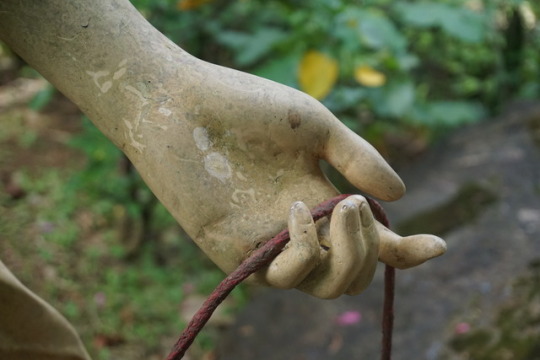


Ariadne
This sculpture of Jerome Samson is uniquely placed along one of the many paths within the museum. And it is brilliant that it portrays Ariadne, an archetypal guiding spirit of the lost and confused. She holds a spool of thread that he says to "provide a path to a consciousness that can emerge from the maze of ideas and the mess of affections with the grace of mindfulness." He puts that freedom from the labyrinthine reality doesn't happen in conquering corners and thresholds but in the knowing of a thin, gentle but keen string that passes so discreetly around obstacles.
0 notes
Photo

ALINGAWGAW
There are two sides in every person, the loob (internal) and the labas (external). Based on traditions, a person should have a calm loob and the labas should correspond with it, labas should always show a symbol of pakikisama. But with the existence of sama ng loob, the balance between the internal and the external would be difficult to achieve since emotions are bottled up inside, unexpressed. The artist, Jerson Samson wanted to show that emotions should be expressed, for us to feel better and free ourselves from the heavy burden we are carrying.
0 notes
Photo


Luksong Tinik
For Filipinos, life is an endless fray. The obstacles waiting ahead of us are must be treasured and can be overcome by keeping the faith, tranquility and resoluteness of heart, and by utmost rendering them to the Almighty Father. There is hope sitting at the end of the line and shall bring all sufferings to an end. Jerson Samson used the game Luksong Tinik as a symbol of Filipino’s creative way to face challenges in life.
0 notes
Photo
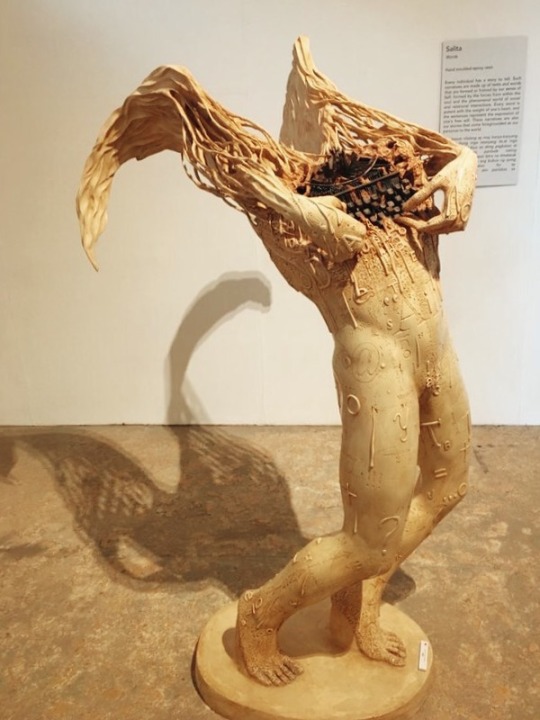

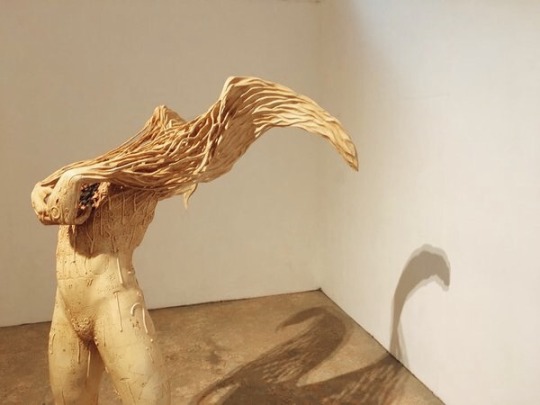
Salita
This work by Jerson Samson shows that every individual has their own stories to divulge. These narratives and words carved deep within our inner peace make up our own identity. What you feed your mind and heart reflects to your persona and affects the world’s perspective of you.
0 notes
Photo
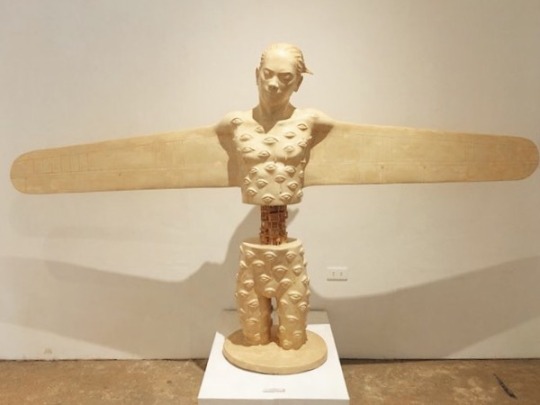

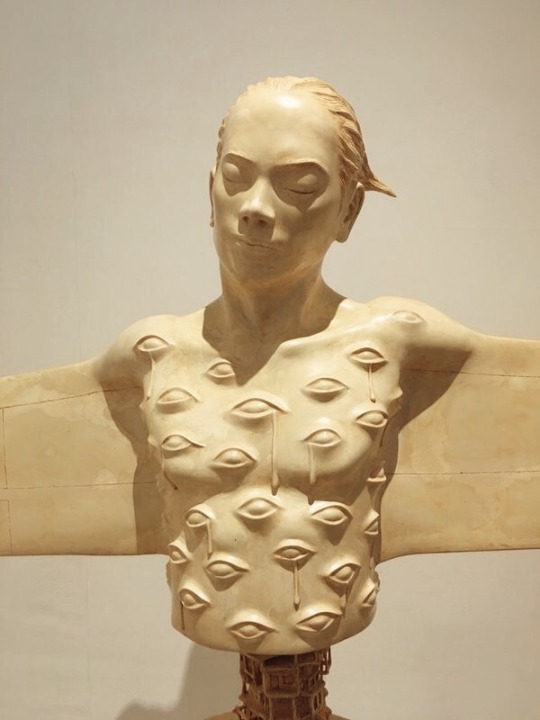
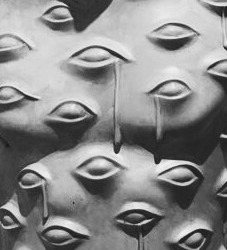
Manananggol
Jerson Samson’s “Manananggol” used a Filipino mythical creature, manananggal to represent Overseas Filipino Workers. This creature divides itself in half at the moment when its predatory hunger occur. Just like the OFWs, they leave their families and half of themselves in their home just to sustain their hunger, by going to another land in hopes of providing their families a better life. He changed the common visualization of wings of a manananggal and turned it into an airplane’s iron wings in his piece to clearly show how they have to fly to a foreign country to achieve that better life that they can’t find in their homeland. Considering the OFWs as new heroes of our nation, he switched the name of ‘mananaggal’ to ‘Mananaggol’ o ‘taga-pagtanggol’.
0 notes
Photo
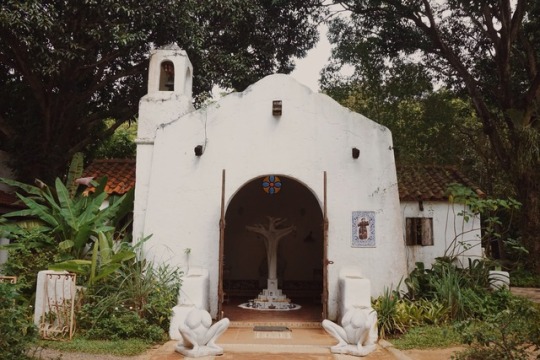




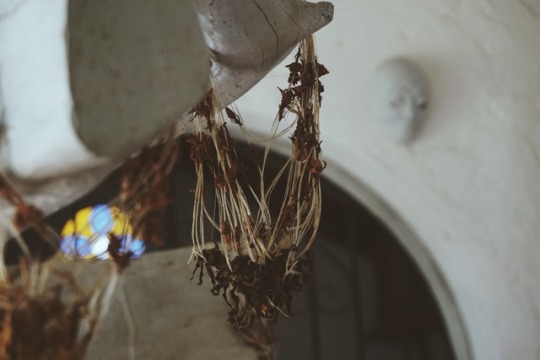
The Oracle
As you enter the Pinto Art Museum, a chapel-like structure called The Oracle will greet you. Intrigued, you will enter the building and see old images of Catholic Saints and the Virgin Mary confined in a prison-cell-like room. But what really stood out inside the ‘chapel’ are two sculptures; an elderly woman, and a tree with a face. On the tree branches, sampaguita garlands which are used to venerate images and statues in honor the holy people represented, are hanged. The whole structure is very intriguing and speaks of something.
This structure shows how Catholicism in the Philippines is influenced by pagan practices. Offerings and garlands (used to venerate saints) being given to the statue of the tree symbolizes the animistic belief of the Filipinos. Also, the elderly woman at the center of what seems to be an altar may represent the albularyo or even witches or mangkukulam. It speaks about how Catholicism is mixed with superstitious beliefs that have been passed on from one generation to another. It may also speak of how Filipino Catholics tend to believe and trust faith healers and the occult practitioners, to the point of setting aside the true teachings of the faith.
Filipinos, however, cannot be blamed if they can’t let go of pagan and occult practices, since these were the norms before Christianity was introduced to us by the Spaniards. From a pious Catholic’s perspective, of course, one cannot “…serve two masters” (Matthew 6:24), as the Sacred Scripture says. A Catholic should not believe in the Christian God and at the same time have faith in the occult. However, using the structural-functionalist lens, the mixture of Catholicism and Filipino Paganism is good for the survival of the Filipino cultural practices and the Filipino society itself. This is because Alfred Reginald Radcliffe-Brown, a renowned structural-functionalist, emphasizes the importance of minimal integration for the society’s survival. The Filipino culture and society cannot survive if the all Filipinos will fully practice Catholicism, since it will result to the eradication of some cultural practices.
This, and much more artworks inside the Pinto Art Museum are waiting for your insights and ideas. Come and explore this museum to understand the Filipino culture by analyzing Filipino art!
#filipino culture#culture#catholicism#paganism#animism#structural functionalism#minimal integration#radcliffe brown#christianity#occult
7 notes
·
View notes